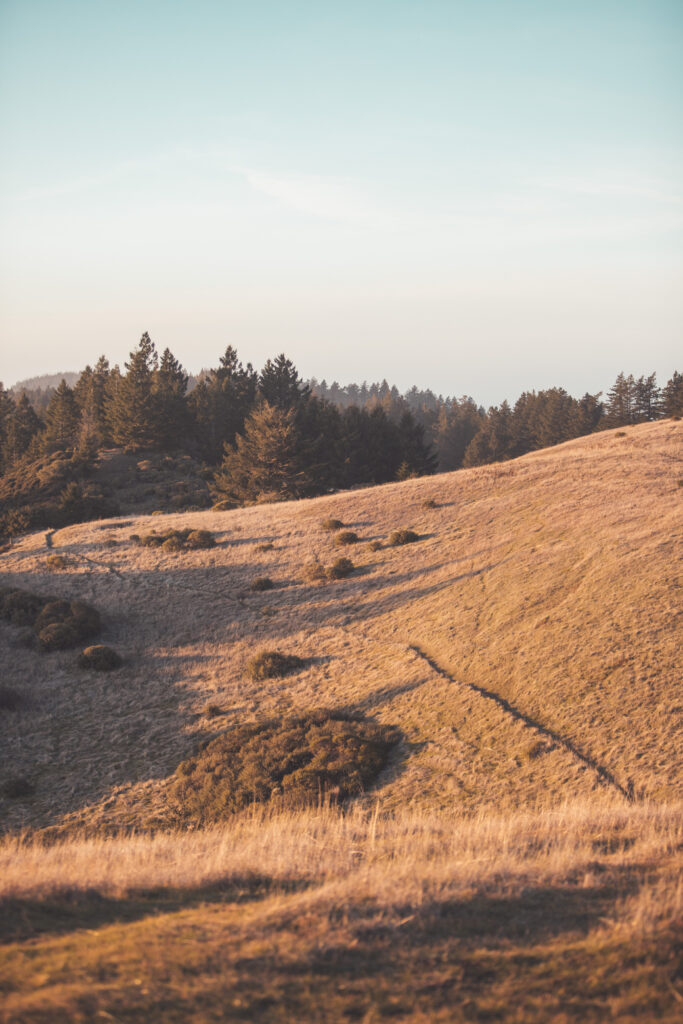Runners Taking Climate Action
Trail and ultrarunners gathered last month for the North Cascades Climate Summit Trail Fest, co-hosted by Aspire Adventure Running and Runners for Public Lands (RPL), at the Mount Baker Mountaineers Lodge outside of Bellingham, Washington. Vic Thasiah of RPL responds to questions that came up there, and shares his runner philosophy on climate action.
What’s recently inspired you as a runner to take climate action?
“We’ll chain ourselves to the trees!” “We’ll sabotage machinery!” “We’ll blockade the forest!” “We’ve got to protect Pine Mountain!” One after another, people said these things at the Los Padres ForestWatch booth my friend and I staffed at a recent Wild & Scenic Film Festival. They were ready to throw their bodies in harm’s way to defend the old-growth forest and expansive chapparal – home to hundreds of species of plants and wildlife – the ancestral homelands of the Chumash called ‘Opnow, and a place loved by trail runners and other recreational groups against the U.S. Forest Service’s decision despite widespread opposition to log and clear the area.
As the sun set and night fell our EZ-UP was filled with an absolutely beautiful rage and joyful resistance at the same time. Together we glowed like bioluminescent phytoplankton in a dark sea. African American writer and filmmaker Toni Cade Bambara (1939-1995) once said that “the role of the artist is to make revolution irresistible.” That’s what the community surrounding the booth did to me.
What are some helpful ways for runners to think about climate action?
“Yippee-ki-yay, Mother F*cker!” is the first thing I think of when there’s talk about taking action. My default setting for action is everything NYPD Detective John McClane does in the Nakatomi Plaza high-rise to rescue hostages, especially his wife Holly, from the clutches of terrorist Hans Gruber and his henchmen. As my Netflix account viewing history will reveal I’ve been obsessed with watching others take such action ever since.
In terms of taking climate action, I’ve also pretty much seen it all. Most recently there’s The Climate Action Handbook by Heidi Roop, which conveniently itemizes 100 things we can do across energy production and transportation, travel and work, food and farming, shopping and consumer choices, actions around the home, nature-based and natural solutions, health and wellbeing, and civic and community engagement. As expected, reading through the 100 things wasn’t nearly as exciting as watching Die Hard for the 100th time.
There’s a more interesting question to ask in response to climate disruption than the action question, “What should I do?” It’s what I call the beingness question, which asks: “Who am I in relation to global warming and the ways it impacts my community and the world?” In other words, who am I becoming as a runner and human being in the face of climate destabilization, ecosystem degradation, biodiversity loss, and the related global poverty and human suffering? A rather daunting existential question, to be sure, but one worth asking and trying to answer.
Why would it be worth it, especially given how overwhelming life already feels? Leadership experts Jim Dethmer, Diana Chapman, and Kaley Klemp, I think, get why: “Action not rooted in beingness is usually short-lived, exhausting, and guilt producing (if I fail to do it). When ‘being’ is prioritized, the doing happens naturally – just as an apple tree does not exert effort to give its fruit to the world. It knows its beingness and rests as apples come forward (doing).” This is why I’m big on beingness.
Of course we still have to ask the climate action question (what should we do?), but from the standpoint of beingness, it now feels less like a “should” question – one asked out of duty, obligation, and responsibility – and more like an invitation. In response to climate disruption, where do I feel invited to make a positive difference that could be enjoyable and meaningful, maybe even fulfilling, along the way? In other words, where could I add beauty, goodness, and/or equitable prosperity to my community and the world just because I can?

How does climate action fit into the bigger picture of protecting the environment?
Asian Americans, like other identity groups, have great insights to contribute to the climate conversation. The most important insight I believe, based on reading ancient Chinese nature poetry, has to do with the utterly wondrous and profoundly mysterious regenerative tissue that continually gives rise to the myriad beings and things of this world. We call this regenerative stuff dao. Dao is the label for the ever-renewing diverse cycle of life, including us, in constant emergence, evolution, dissolution, and reemergence, akin to the rhythm of breathing. As life’s diversity holds the utmost value, our highest calling is to live fully, in harmony with its regenerative essence.
This concept of regeneration, based on deeply connecting with the people and places we care about, is a good guide for runners taking climate action. Grounded in a reverence for and reciprocity with the natural world characteristic of Indigenous stewardship, regenerative climate action promotes both ecosystem health and everyone’s prosperity. This is consistent with the values and priorities of environmental justice work – leaving lands, waters, and the climate in better shape for our children and future generations.
Regeneration “means putting life at the center of every action and decision,” according to foremost regeneration expert Paul Hawken. He explains, “Reversing the climate crisis is an outcome. Regenerating human health, security and well-being, the living world, and justice is the purpose.” Principles for runners taking regenerative climate action are: equitable prosperity for all; reducing both fossil fuel carbon emissions, and energy and material use; protecting lands and waters, ecosystems and habitats; sequestering carbon through both regenerative agriculture and the restoration of degraded lands and waters; influencing laws, regulations, subsidies, policies, and building codes; and supporting organizations doing any of the above.
Adapting Bambara’s perspective, how can we as runners make regeneration irresistible?
Recalling her dear friend Toni Cade Bambara, who sought to make revolution irresistible, writer Pearl Cleage once remarked: “Bambara…didn’t like to call herself an artist because then it made you start acting precious like you were so above everybody else…she thought that we should call ourselves cultural workers because we were no better than people who worked in factories, no better than people who taught school, no better than people who were nurses and doctors and all of that. We were cultural workers.”
Runners will make a difference in addressing climate destabilization when as many of us as possible use our running and our other interests and skillsets to do the creative cultural work of making the regeneration of our communities and ecosystems so enjoyable and fulfilling that it’s irresistible. Think of all of the parties, parades, protests, art, music, film, TV, fiction, poetry, memoirs, plays, philosophies, natural and social scientific work, teach-ins, organizing, community building, mobilizing, policymaking, lawsuits, celebrity and athlete influence, and the many other things that over a century led to the legal recognition of same-sex marriage. It’s going to take a similar amount of cultural work from runners and everyone else to shift, and keep the shift going, into a regenerative society.
We’re up against powerful economic incentives for corporate executives and employees, and related consumer attitudes and behavior; political incentives for parties, elected officials, and candidates; and cultural incentives such as symbols of wealth and success, not to mention our racism, classism, nativism, etc. Runners together with others must organize and mobilize a comparable counterforce for a just transition from an extractive to a regenerative economy.

Can our individual and collective efforts as runners really make a difference?
I’m neither Catholic nor religious, but I think Pope Francis gets it on the potential of individual and collective climate action. He knows the most effective solutions come from major national and international agreements, compliance, and accountability, but he also knows “there are no lasting changes without cultural changes, without a maturing of lifestyles and convictions within societies, and there are no cultural changes without personal changes.” In other words, it begins with personal, family, and community habits, which he observes naturally leads to “indignation at the lack of interest shown by the powerful” and confronting them, when necessary, to change course. Thus, organizing and mobilizing even just a fraction of the runners in the U.S. – 65 million strong, 20 percent of the population – changes the world.
Why should families that celebrate Christmas consider making Die Hard their annual family Christmas movie?
Even though the setting for Die Hard is an office Christmas party, it’s not going to be easy selling my wife and daughters on it as our annual family Christmas movie. The case I’ll make is that it’s a story about doing whatever it takes (like McClane does) to reconnect with who and what we’ve loved and lost (McClane desperately trying to rescue his estranged wife, who’s being held hostage by powerful bad guys) for the sake of regeneration (McClane and Holly’s renewed marriage by the end).
